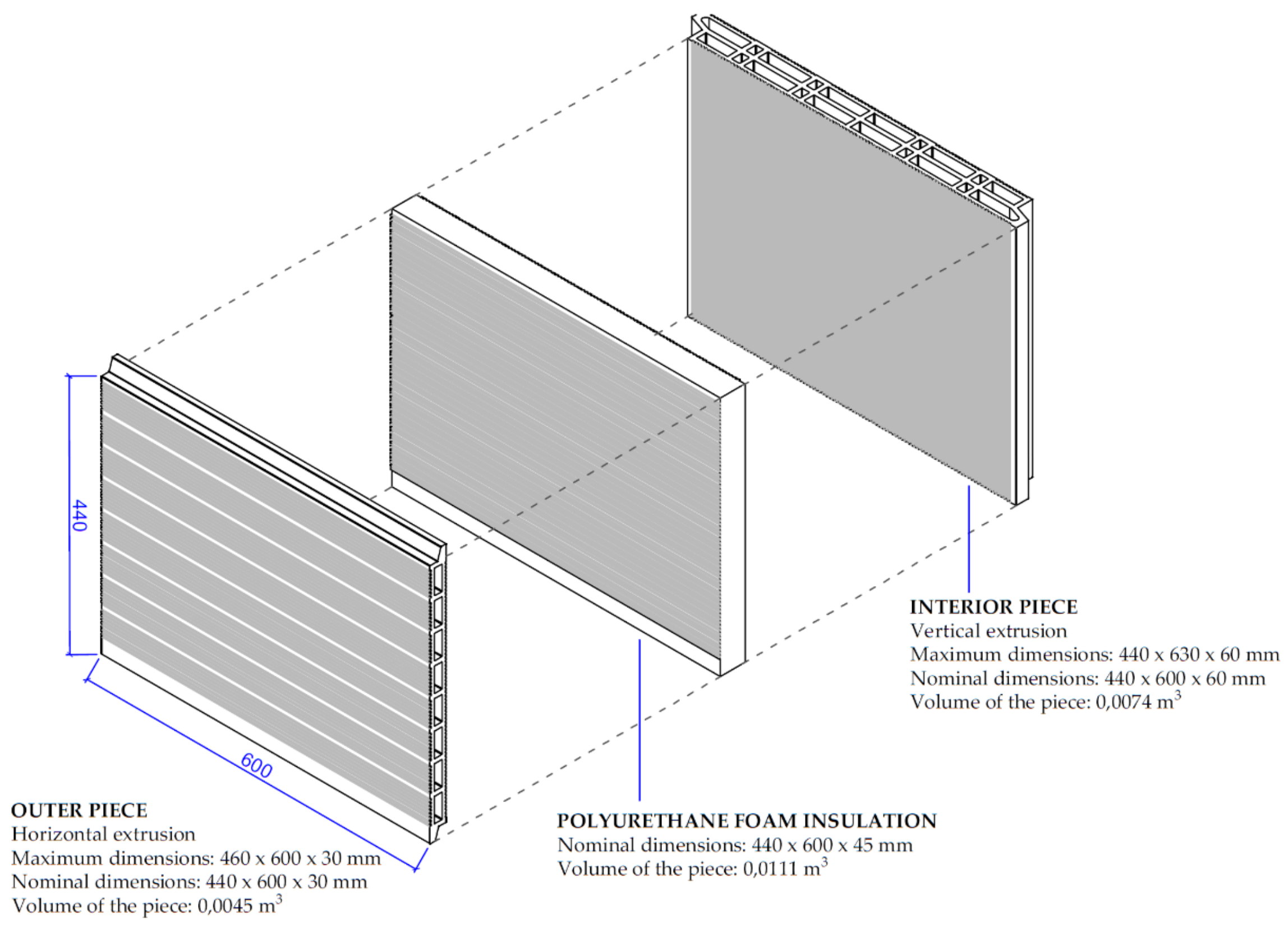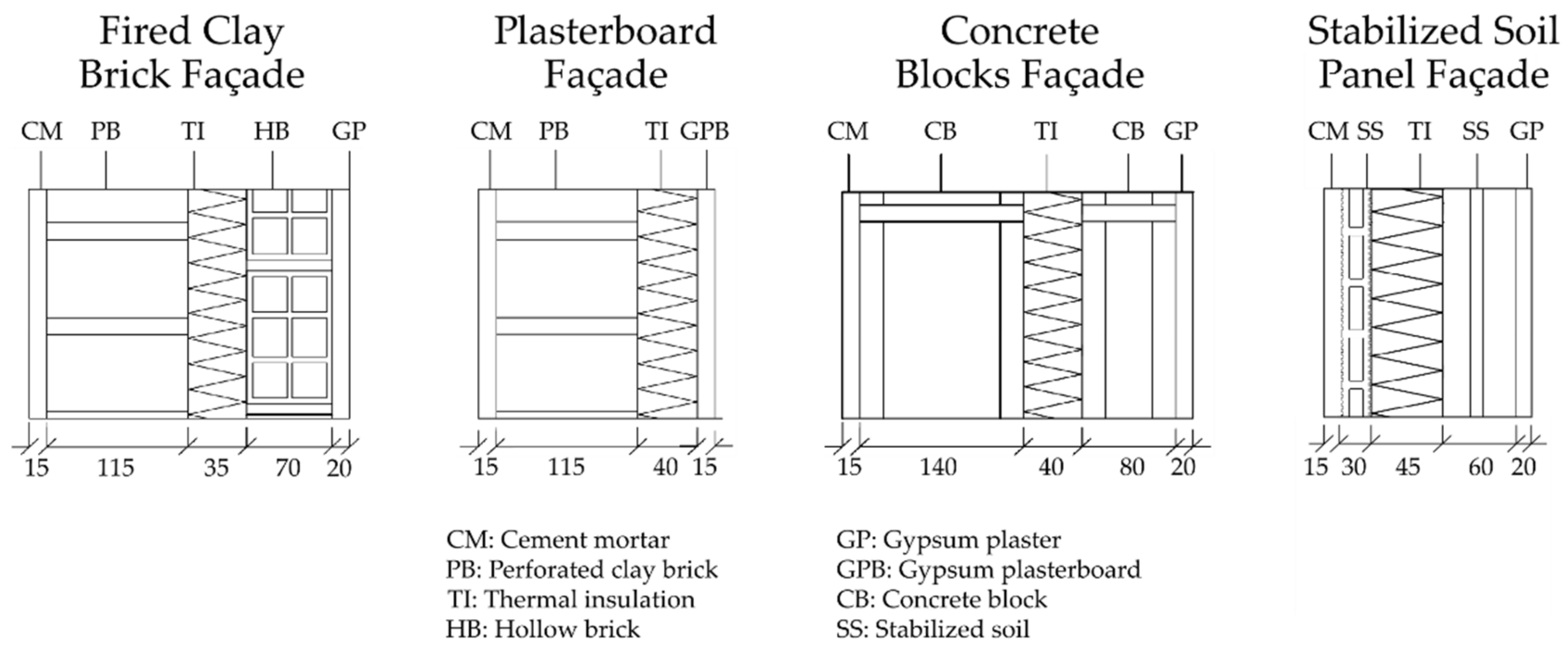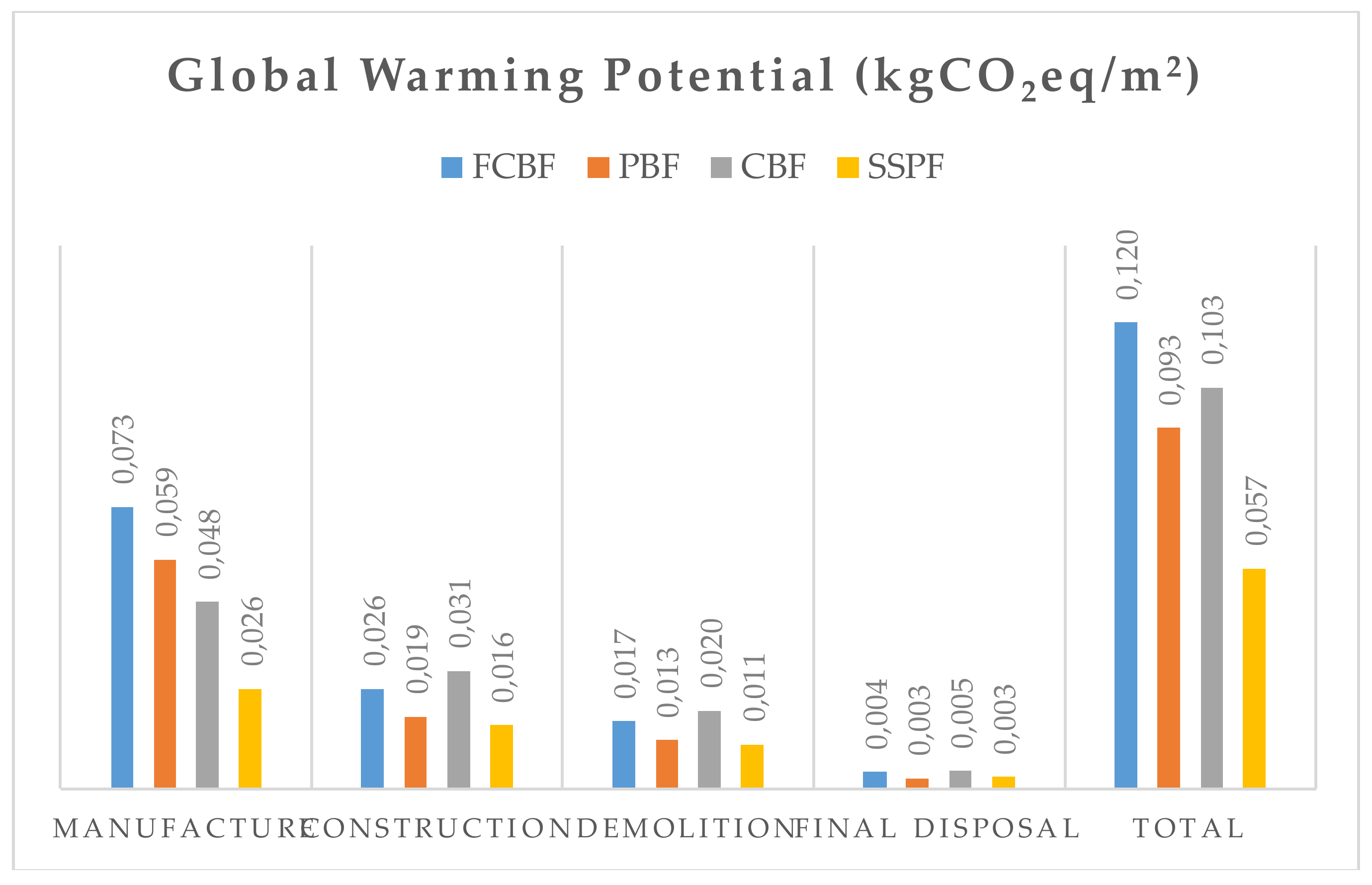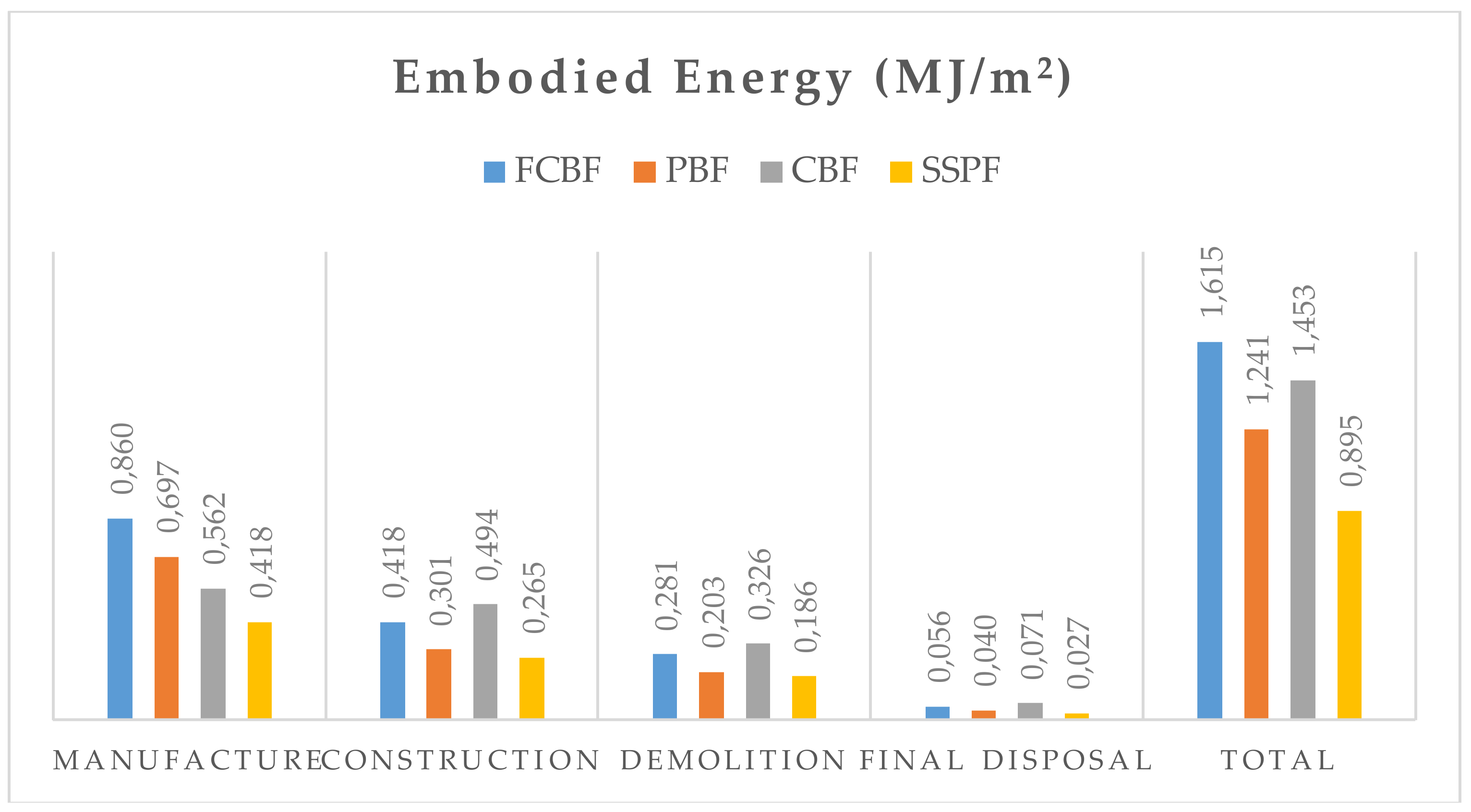1. Introduction
According to current knowledge, earthen building materials have been used worldwide since the Neolithic times. However, in spite of its antiquity, nowadays the use of these materials continues to be generalized mainly due to its eco-friendliness profile [
1,
2,
3,
4,
5] and also for restoration purposes and for the conservation of traditional architecture [
6,
7]. Taking into account the fact that most of the current ceramic construction technologies are based on the use of high temperature furnaces for the drying and hardening of the materials—which implies a significant increase of the embodied energy and CO
2 emissions—the development of techniques and materials that avoid these baking processes would substantially reduce the environmental impact of the building [
8,
9,
10,
11,
12,
13,
14].
Notwithstanding the above, the natural drying process is considerably slower than conventional technologies and the long duration processes are large penalties in terms of the effective costs and construction time. That reason justifies that a major requirement for the production system of these earthen materials is to produce them as industrialized as possible so that they can cope with the rhythm marked by the construction and thus, mitigate the slower production process effects through efficient production scheduling. The factors, in order of impact, that significantly prevent the effective application of sustainable materials are the lack of demand, the green construction culture, the high costs of sustainable construction materials, and the lack of knowledge regarding sustainable construction materials. The second of these factors is especially important in terms of truly implementing green materials in the construction sector. It should be pointed out that the selection of building materials is a very important and complex task in every construction project [
15], which can be determined with numerous preconditions, decisions, considerations, and detailed information on the building materials and products [
16]. With regard to this issue, there are several studies performed in order to reveal the cost of green buildings in comparison to conventional-standard buildings. The first published studies yielded considerably higher global cost values than the most recent ones [
17,
18,
19,
20]. Conversely, current research suggests that the cost of green buildings is nowadays only slightly higher than conventional technologies [
21,
22].
However, more importantly, the use of sustainable materials in construction to replace conventional materials enhances the overall environmental sustainability and reduces the environmental impacts during the building life cycle. The use of environmentally friendly materials in building construction preserves natural resources and reduces pollution [
23]. Therefore, the main objective of this work is to verify both aspects simultaneously. That is to say, to confront with different conventional non-bearing façade systems with a new alternative made from stabilized earth panels, verifying the environmental and economic costs at the same time; understanding that this both-sides analysis is a more realistic decision-making methodology that provides effective options for green materials to be incorporated gradually into the construction sector.
3. Research Aim and Methods
The main aim of this study is to carry out an economic and environmental comparison of a non-bearing façade solution based on the extruded panels made of stabilized soil versus three traditional solutions of similar physical, thermal, and aesthetic characteristics; the latter in terms of the outer and inner cladding. The functional unit is defined as a meter squared façade in order to balance the necessary quantities of material and determine the economic cost and environmental impact of each solution.
For the economic comparison, unitary cost studies are developed based on the Andalusian Construction Cost Database (ACCD) [
24], a cost control support in the construction sector with more than 30 years of continuous development and use, which is based on the contributions of a considerable number of professionals with extensive experience in this sector. In this case, a cost development methodology with a hierarchical structure is used, developing simple costs (SC) for each layer of the façade solutions to be studied, and complex costs (CC) for the complete solutions, which are composed of several SCs.
The data for the environmental impact study of the solutions are obtained through life cycle assessment (LCA) using the Cumulative Energy Demand (CED) methodology to obtain their embodied energy and the Global Warming Potential (GWP 100a) category of CML 2001 for the emission factor. Simapro 8 [
25] is used for this assessment, with Ecoinvent 3 [
26] as the LCA database, which was identified by Martínez-Rocamora et al. [
27] as the most comprehensive database for environmental studies in the construction sector. Data for the embodied energy and emission factor of sheep wool and alginate were obtained from recent studies by Barber and Pellow [
28] and Resurrección et al. [
29], respectively.
Table 1 shows a list of the extracted data for every material and process included in the environmental assessment of the façade solutions that are under study.
The analysis covers the manufacturing, construction, deconstruction, and final disposal processes. The total service life of the façade solutions has been estimated at 50 years, according to ISO 14040 [
30] and ISO 14044 [
31]. The operational energy has not been considered in the calculations since the thickness of the thermal insulation for all the façade solutions that are under study has been chosen to equal their thermal transmittance values (U-value) (~0.500 W/m
2·K), which will cause scarce differences in energy consumption. Likewise, maintenance operations are dismissed, since they just consist of repairing 2% of the outer and inner coatings every 25 years [
32], which does not influence the decision of which base material to choose for the façade. Therefore, the life cycle phases included in the system are the following:
Manufacturing. For each construction material used, a cradle-to-gate life cycle assessment is carried out, leaving transport included in the construction phase, and the final disposal in the last phase in this list.
Construction. This phase covers the transport of materials from the manufacturing point to the construction site, as well as the energy and fuel consumption for the construction of the studied solutions.
Demolition. This phase considers the energy and fuel required for the demolition of the façade components and their transport to the final disposal location.
Final disposal. This phase includes the disposal and recycling processes for the waste generated by the demolition process.
The calculation procedure to obtain the life cycle inventory for the environmental assessment is described by García-Martínez [
33], which consists of the following steps:
Identify and quantify the main and auxiliary products.
Identify and quantify the basic processes related to construction and demolition. The electricity and fuel consumption in the construction and demolition works are obtained through a conversion factor proportional to the total volume of construction materials involved, according to the procedure described by Kellenberger et al. [
34].
Determine the inputs and outputs of each unitary process. In this study, a selective final disposal has been assumed, where the waste materials are classified according to their nature. The quantification of the materials for their final disposal is equal to the quantity of materials originally consumed to build the various façade solutions.
Elaboration of the life cycle inventory and the application of assessment methodologies. In this case, as it has been stated before, the CML 2001 and Cumulative Energy Demand methodologies have been applied in order to obtain the emissions of equivalent CO2 (kgCO2eq) and the embodied energy (MJ) for the materials and processes identified.
4. Conventional and Unconventional Materials Analyzed
The conventional constructive solutions selected for this study are most commonly used in residential buildings in Spain according to the Spanish Technical Code—CTE—in the construction sector [
35].
These solutions are (
Figure 3) a double-sheet façade made of ceramic brick (FCBF), a façade where the inner sheet is replaced with plasterboard (PBF), and another double-sheet façade of concrete block masonry (CBF). The unconventional solution consists of a double-sheet façade of stabilized soil panels (SSPF). In all of them, the use of polyurethane foam is assumed as a thermal insulator, with different thicknesses to balance their U-values. Likewise, they are all coated with cement mortar on the outside and gypsum plaster on the inside, except the PBF, whose inner sheet already consists of plasterboard. Thus, the results of the comparison clearly reflect the implications of the use of one material or another for the support sheets.
4.1. Fired Clay Brick Façade (FCBF)
The first façade solution under study consists of a double sheet of ceramic brick with an intermediate thermal insulation. The outer sheet has a thickness of 11.5 cm, with perforated bricks of 240 × 115 × 50 mm3 taken with cement mortar, while the inner sheet—7 cm thick—is built with double hollow bricks of 240 × 115 × 70 mm3. Ceramic bricks are subjected to temperatures between 1000 °C and 1200 °C, which translates into an embodied energy of 3.81 MJ/kg and an emission factor of 317 kgCO2eq/kg. The thermal insulation required to match the thermal characteristics of the solutions under study must be 35 mm thick in this case.
4.2. Plasterboard Façade (PBF)
This solution requires a supporting outer sheet with a minimum solidity, for which an 11.5 cm thick ceramic brick masonry is usually used, as in the previous solution (FCBF). The inner sheet, on the other hand, is formed by plasterboard panels anchored to the support wall with metal profiles every 40–60 cm. In the space between both sheets and the profiles, a 40 mm thick thermal insulation layer is placed in order to obtain a U-value of 0.500 W/m2·K. This solution does not have an internal coating of gypsum plaster since the inner sheet is already formed by that material and is directly coated. The use of the gypsum board involves the emission of 0.406 kgCO2eq/kg and an embodied energy of 5.73 MJ/kg, but the main disadvantage of its use is that it involves the installation of a galvanized steel structure that produces 4.55 kgCO2eq/kg and consumes 6.36 MJ/kg, only to be relieved by the savings on the environmental impact in future cycles due to the recycling processes.
4.3. Concrete Block Façade (CBF)
This façade solution consists of two sheets of concrete blocks, with thermal insulation between them and cement mortar coatings on the outside and gypsum plaster on the inside. Most of the environmental impact of the concrete blocks depends on the amount of cement used in the mixture, but on average they generate 0.0905 kgCO2eq/kg and consume 0.884 MJ/kg. In the solution studied, blocks of 390 × 190 × 140 mm3 are used for the outer sheet, and 390 × 190 × 80 mm3 for the inner sheet, with apparent densities of 1000 and 1220 kg/m3, respectively.
4.4. Stabilized Soil Panel Façade (SSPF)
The mixture of components described in
Section 2 is made in proportions by weight of 76.75% clay, 20% water, 3% alginate, and 0.25% sheep wool fiber. However, only 7% of water remains incorporated into the piece once it is dry, while the remaining 13% is lost through evaporation.
Unlike conventional façade systems made of compressed soil blocks in which the weight of the material penalizes GWP and Embodied Energy EE, the present design aims to lighten the piece through a method of stabilization of the soil and by including a molding extrusion in the manufacturing of a sandwich which also incorporates an inner layer for thermal insulation.
Table 2 shows the calculation of the emission factor and the embodied energy per kg of stabilized soil material, which serves as the basis for the life cycle assessment of the façade solution. The calculation has been carried out for both the outer and inner panels in order to ensure the coherence and solidity of the data obtained. As a result, the emission factor and the embodied energy to be considered in this study are 0.088 kgCO
2eq/kg and 1.924 MJ/kg, respectively.
In order to illustrate the procedure followed for the environmental and economic analysis of the different façade solutions, the corresponding calculations for the façade of stabilized soil panels are used as an example.
Table 3 shows the calculations of thermal transmittance (U-value), volume, and weight of the materials that make up the façade. The U-value is obtained through the thermal resistance of the materials of each layer, according to Spanish regulations CTE DA DB-HE1 [
36]. This procedure has been used to adapt the thermal insulation thicknesses of each solution in order to be comparable as possible substitutes for each other for the same climatic demands. The volume and weight of the materials serve as the basis for calculating the environmental impact of all the processes related to the different phases of their life cycle, given that LCA databases usually contain emission and embodied energy factors by kg of material.
Once the weight of each material that forms the façade solution (per m
2, chosen as a functional unit) is obtained, the emission and embodied energy factors from
Table 1 are applied to determine the environmental impact of both the complete solution and each phase of its life cycle (see below
Table 4).
For the economic assessment, a total of 11 simple costs (SC) and 4 complex costs (CC), as defined in
Section 3 (one for each façade solution), have been developed; the latter comprising 3–5 SCs, depending on the number of layers of which they are composed. In
Table 5,
Table 6 and
Table 7 the elaboration of the 3 SCs that make up the SSPF solution are shown, all of them being included in the CC of
Table 8, which has 1 m
2 of each of them.
5. Results and Discussion
The calculation described in the previous section is carried out with each of the four façade solutions in the comparison, thus, allowing for the study of the differences in terms of GWP (
Figure 4) and EE (
Figure 5) in each phase of their life cycle. The construction and demolition phases show a proportionality between the results, obviously because the calculation method used depends exclusively on the weight and volume of materials, with higher electricity and fuel consumption factors for the first phase. Precisely for this reason, although the CBF solution has a lower impact in the manufacturing phase, this difference is compensated in the total by its greater weight and volume, which affects the results of the construction and demolition phases, hence, overcoming the total environmental impact of the PBF option despite the latter having a considerably lower weight and volume.
Regarding the results obtained for the SSPF solution, these are clearly lower than the rest of the options in all of the phases, which is explained by the absence of any firing processes in their manufacture, as well as by their lower weight and volume. In addition, being made up of inert materials—with the exception of thermal insulation—the final disposal provokes a smaller impact, although, as it has been proven, the last phase represents a less significant part of the total environmental impact of materials (~4%).
These analyses allow for the determination that the environmental impact of the SSPF solution, both in terms of GWP and EE, is approximately 40% that of the rest of solutions. This is a very satisfactory result compared to those obtained in previous studies in which this type of solution was applied to load-bearing walls [
37,
38].
According to the cost evaluation in
Table 5,
Table 6,
Table 7 and
Table 8, the total cost obtained for the SSPF solution is 52.43 €/m
2, a significantly lower value compared to the rest of the solutions, mainly due to the absence of the base material’s firing process. Although, at the moment, the difference is less significant due to the scarce industrialization of the production since it is a new material currently in development. It is estimated that, with a greater insertion into the market of construction products and greater automation in the manufacturing system, it could become more profitable, with its cost per m
2 decreasing down to 30% below the levels of the other façade solutions.
Finally,
Table 9 shows a comparative summary of the results in terms of volume, weight, thermal transmittance, environmental impact, and costs. As can be observed, with similar thermal characteristics, the volume of the façade required with the SSPF solution is lower than that of traditional solutions, partly caused by the use of a thermal insulation 10 mm thicker than that of the FCBF solution.
The weight of the unconventional solution presented in this study also becomes a decisive factor since it can serve to diminish the load that the structure of the building must support, which would allow for the reduction of the consumption of structural material and with it, the environmental impact of the entire building. In addition, the considerable difference in environmental impact with respect to conventional solutions confirms that the way to reduce the emissions generated by the construction sector is to develop materials with slower but more natural raw materials and manufacturing processes, which is not always applicable to countries in intensive development.
In light of the above, and considering that the operational energy has been equalised for all four systems by means of their U-values, it can be concluded that the main comparison factors are the EE, the GWP, and the economic cost of all four solutions.
Regarding the EE, the energy demand of the proposed new system (the SSPF) was 45% lower than the most demanding one, the FCBF, and even 28% lower than the conventional one which showed the lowest embodied energy, that is, PBF. Concerning GWP, SSPF produces 54% fewer emissions than FCBF and even 40% less than PBF, the conventional solutions with the highest and lowest values, respectively.
Last but not least, the economic analysis shows that the proposed system (the SSPF) is 30.5% cheaper than CBF—the most expensive among the conventional solutions—and 22% cheaper than the cheapest solution, PBF.













